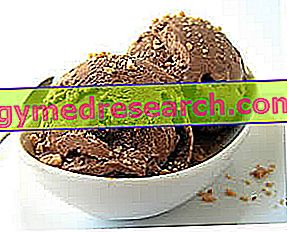Summary: Ice Cream Components
Before analyzing every single stage that will lead to the production of ice cream, we briefly describe all the components of the mixture, also focusing on their function.

Among the "auxiliary" components of the ice cream mixture, we cannot forget the fats, which are mainly found in milk, cream, butter and egg yolks. Also margarine (vegetable fat) is sometimes used to increase the amount of fat in the mixture. An exact dosage of fats gives creaminess to the final product, improves the organoleptic characteristics of the ice cream and helps to increase the amount of air incorporated during the freezing phase (overrun).
To prepare a quality ice cream, we cannot omit the SLNG, or those components considered " Solids of Non-Fat Milk ". SLNGs represent what remains of milk after removing fats and water, and are made up of proteins, lactose and mineral salts. SLNGs are important because they contribute to giving body to ice cream, reduce the amount of frozen water in the finished product, stabilize the mass and retain the air contained in the mixture, ensuring its overrun.
The addition of some emulsifiers and stabilizers / thickeners for ice cream can further improve the structural characteristics of the finished product. This category includes: carob seed flour, guar gum, sodium alginate, mono / glyceride fatty acids and soy lecithin.
To prepare an ideal ice cream it is essential to respect (in order) 5 distinct phases:
- Balancing and preparation of the mixture
- Pasteurization of the compound
- Maturation of the mixture
- Creamy ice cream
- Firming ice cream
Balancing of the mixture
Balancing the mixture is essential to obtain an ice cream with ideal characteristics.
When the mixture is not properly balanced, the ice cream may appear sandy, rubbery or elastic; other times the ice cream melts quickly, it is too sweet or frothy.
To overcome all these drawbacks it is advisable to carefully balance the mixture, thus studying the components (milk, cream, egg yolks, fruit etc.) and the percentage of fats, sugars and other solids contained in each of them.
The basic recipe of ice cream will be ready only when the ice cream maker has carefully chosen the ingredients and established the exact quantity of each in the mixture formulation.
To understand...
Essentially, balancing the mixture is important to ensure that all the flavors of the ice cream, ideally combined in a giant cup, behave in the same way and are equally creamy, spreadable and sweet "at the right point".
To understand the importance of balancing a mixture, we give a practical example. We choose three different ice cream flavors and imagine bringing them together in a small bowl: with cream, hazelnut and strawberry. If the mixture is not adequately balanced, the risk is to have a creamy ice cream too sandy and not at all creamy (excess of lactose), a hazelnut ice cream too fluid and lacking in body (too much sugar) and a grainy strawberry ice cream, compact and with large ice crystals (few sugars).
Only through the correct balance, will it be possible to guarantee a soft, spreadable, creamy and velvety ice cream, regardless of the tastes chosen.
Balancing is therefore essential to ensure that all ice creams - distinguished according to the "yellow base", "white base", "fruit base" category - possess the same structural characteristics, hence the correct percentage distribution of fat, SLNG sugars ( Non-fat milk solids), other total solids and solids.
How do you balance the mixture?
As already repeated several times, in order to obtain a correct balance of the mixture it is necessary to proportion sugars, fats, SLNG and other solids that make up the individual ingredients.
The limits for balancing cream, cream and fruit mixtures are shown in the following table:
| Type of base for ice cream | Sugars % | Fat% | SLNG% | Other solid% | Total Solids% |
| Base for cream or cream ice cream | 16-22 | 6-10 | 8-11 | 1-5 | 32-42 |
| Fruit ice cream base | 26-30 | 0 | 0 | 0.2-0.5 | 30-35 |
Depending on needs and requirements, an ice cream can be formulated with a minimum or maximum dose of sugar and fat. In no case, however, is it advisable to go below the minimum percentages or exceed the maximum threshold to avoid unbalance of the mixture: in these cases, the ice cream could lose its structural and organoleptic qualities.
At this point a question arises: how is it possible to know the quantity of sugars, fats, proteins and other solids contained in each ingredient?
It is important to observe the nutritional composition of the ingredients by analyzing reference tables, in which the quantities of sugars, fats, proteins, milk solids and other solids contained in each food are specified.
Below is the nutritional table of the main components of an ice cream mixture.
| Ingredient | Sugars % | Fat% | Solid milk% | Other solids | Total solids |
| Natural milk | - | 3 | 9 | - | 12 |
| Skim milk powder | - | - | 100 | - | 100 |
| Powdered milk | - | 26 | 72 | - | 98 |
| Sweetened condensed milk | 40 | 12 | 27 | - | 79 |
| Liquid cream | - | 35 | 6 | - | 41 |
| Butter | - | 82 | - | - | 82 |
| Sucrose | 100 | - | - | - | 100 |
| Dextrose | 100 | - | - | - | 100 |
| Glucose syrup | 80 | - | - | - | 80 |
| Invert sugar | 80 | - | - | - | 80 |
| Honey | 80 | - | - | - | 80 |
| Egg yolk | - | 30 | - | 15 | 45 |
| Egg white | - | - | - | 12 | 12 |
| Whole egg | - | 11 | - | 14 | 25 |
| Stabilizers | - | - | - | 100 | 100 |
To make fruit ice creams, you need to know the amount of sugar contained in the chosen fruit. In this type of formulations, the calculation of sugars and solids is obviously more complex, not only because the percentage of sugars changes from fruit to fruit, but also because the same quantity is influenced by the degree of ripeness of the fruit, by the harvest period and from the place of origin.
The artisan ice cream maker is always advised to use ripe fruit and to respect the seasonality.
Below are the average nutritional values of the most commonly used fruit for preparing ice creams.
| Fruit | Sugars % | Solids% |
| Apricot | 9 | 9 |
| Pineapple | 8 | 3 |
| Watermelon | 6 | 5 |
| Orange | 6 | 8 |
| Banana | 16 | 9 |
| cherries | 10 | 6 |
| figs | 12 | 8 |
| strawberries | 7 | 7 |
| Raspberries | 7 | 8 |
| Lemon | 3 | 7 |
| Tangerine | 8 | 8 |
| Mango | 12 | 8 |
| Maracuja | 7 | 4 |
| Apple | 8 | 6 |
| Melon | 8 | 5 |
| Papaya | 8 | 7 |
| Pere | 9 | 5 |
| peaches | 9 | 9 |
| Tomato | 4 | 4 |
| Grapefruit | 8 | 6 |
| Currant | 6 | 9 |
| Grapes | 20 | 5 |



